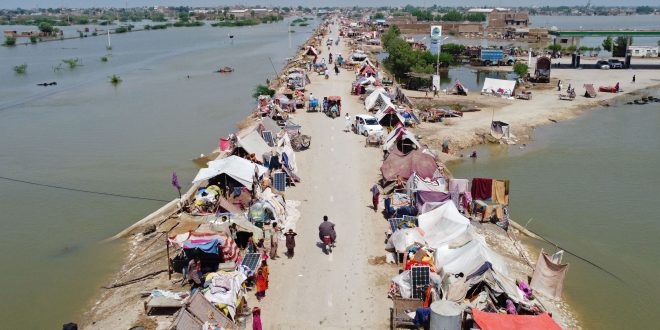Islamabad – Pakistan is currently battling with a horrific flood. A third of the South Asian country has been submerged in water. The death toll in Pakistan has risen to 1343 with 18 more deaths on Wednesday. Meanwhile, Prime Minister Shahbaz Sharif became emotional after visiting the flood-affected areas of the country. He said that Pakistan is looking like the sea.
Officials in Pakistan estimate that 33 million people out of a population of 220 million have been affected in this disaster caused by climate change. Lakhs of people have become homeless and Pakistan’s economy has suffered a loss of at least $10 billion.
“You wouldn’t believe the scale of destruction there,” Shahbaz Sharif told the media after his visit to the southern province of Sindh. “As far as you can see, it’s water everywhere. It’s just like the ocean.” He said the government, which has increased cash assistance for flood victims to 70 billion Pakistani rupees ($313.90 million), will also buy 200,000 tents for displaced families.
Sharif said depleting water threatens a new challenge in the form of water-borne infectious diseases. “We will need trillions of rupees to deal with this calamity,” he said. On the other hand, the United Nations has announced $ 160 million in aid to help the flood victims.
Significantly, the most affected area of Pakistan’s devastating rains and then floods is Sindh province. Here Pakistan’s largest fresh water lake has taken a dangerous and formidable form. One lakh people have been displaced from here in the special operation of Pakistani Army.
National disaster officials said eight children were among those killed in the last 24 hours. Record monsoon rains and melting glaciers caused floods in the northern mountains of Pakistan. A top official of the United Nations Refugee Agency (UNHCR) has warned that the situation could worsen with the possibility of more rain in the coming months. The World Health Organization has already said that more than 6.4 million people in flooded areas need humanitarian aid.
The floods in Pakistan have destroyed 1.6 million homes, 5,735 km (3,564 mi) of transport links, 750,000 livestock and more than 2 million acres (809,370 ha) of agricultural land. Pakistan has received nearly 190 percent more rainfall than the 30-year average, totaling 391 mm (15.4 inches), while Sindh has recorded the highest average rainfall of over 466%.
 Indian Thought Latest News & Views
Indian Thought Latest News & Views



